Cumin
| Cumin | |
|---|---|
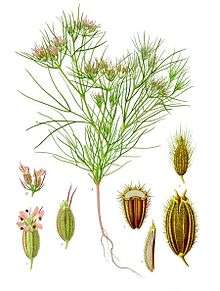 | |
| Scientific classification | |
| Kingdom: | Plantae |
| (unranked): | Angiosperms |
| (unranked): | Eudicots |
| (unranked): | Asterids |
| Order: | Apiales |
| Family: | Apiaceae |
| Genus: | Cuminum |
| Species: | C. cyminum |
| Binomial name | |
| Cuminum cyminum L.[1] | |
Cumin (/ˈkjuːmᵻn/ or UK: /ˈkʌmᵻn/, US: /ˈkuːmᵻn/) (Cuminum cyminum) is a flowering plant in the family Apiaceae, native from the east Mediterranean to South Asia.
Its seeds (each one contained within a fruit, which is dried) are used in the cuisines of many different cultures, in both whole and ground form. It also has many uses as a traditional medicinal plant.[2]
Etymology
The English "cumin" is derived from the Old English via Latin cuminum[3] from the Greek κύμινον (kyminon),[4] which is related to (kammon) and Arabic (kammūn).[5]
Description
Cumin is the dried seed of the herb Cuminum cyminum, a member of the parsley family. The cumin plant grows to 30–50 cm (12–20 in) tall and is harvested by hand. It is an annual herbaceous plant, with a slender, glabrous, branched stem that is 20–30 cm (8–12 in) tall and has a diameter of 3–5 cm ( 1 1⁄4–2 in).[6] Each branch has two to three sub-branches. All the branches attain the same height, therefore the plant has a uniform canopy.[6] The stem is coloured grey or dark green. The leaves are 5–10 cm (2–4 in) long, pinnate or bipinnate, with thread-like leaflets. The flowers are small, white or pink, and borne in umbels. Each umbel has five to seven umbellts.[6] The fruit is a lateral fusiform or ovoid achene 4–5 mm ( 1⁄6– 1⁄5 in) long, containing two mericarps with a single seed.[6] Cumin seeds have eight ridges with oil canals.[6] They resemble caraway seeds, being oblong in shape, longitudinally ridged, and yellow-brown in colour, like other members of the Umbelliferae family such as caraway, parsley, and dill.
History
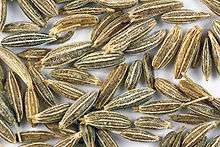
Cumin has been in use since ancient times. Seeds excavated at the Syrian site Tell ed-Der have been dated to the second millennium BC. They have also been reported from several New Kingdom levels of ancient Egyptian archaeological sites.[7] In the ancient Egyptian civilization, cumin was used as spice and as preservative in mummification.[6]
Originally cultivated in Iran and the Mediterranean region, cumin is mentioned in the Bible in both the Old Testament (Isaiah 28:27) and the New Testament (Matthew 23:23). The ancient Greeks kept cumin at the dining table in its own container (much as pepper is frequently kept today), and this practice continues in Morocco. Cumin was also used heavily in ancient Roman cuisine. In India, it has been used for millennia as a traditional ingredient in innumerable recipes, and forms the basis of many other spice blends.
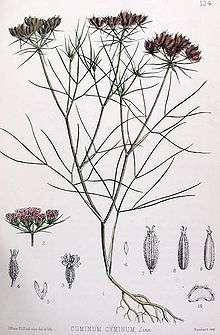
Cumin was introduced to the Americas by Spanish and Portuguese colonists. Several different types of cumin are known, but the most famous ones are black and green cumin, both of which are used in Persian cuisine.
Today, the plant is mostly grown in Pakistan, India, Uzbekistan, Tajikistan, Iran, Turkey, Morocco, Egypt, Syria, Mexico, Chile, and China. Since cumin is often used as part of birdseed and exported to many countries, the plant can occur as an introduced species in many territories.[8] Cumin occurs rarely as an introduced species in the British Isles, mainly in Southern England, but the frequency of its occurrence has declined greatly. According to the Botanical Society of the British Isles' most recent atlas, only one record has been confirmed since 2000.
Cultivation and production
Cultivation areas
The main producer and consumer of cumin is India. It produces 70% of the world supply and consumes 90% of that (which means that India consumes 63% of the world's cumin). Other producers are Syria (7%), Iran (6%), and Turkey (6%). The remaining 11% comes from other countries. In total, around 300,000 tons of cumin per year are produced worldwide. In 2007, India produced around 175,000 tons of cumin on an area of about 410,000 ha., i.e. the average yield was 0.43 tons per hectare.[6] The Maltese island of Comino is named for the plant that grows wild there.
Climatic requirements
Cumin is a drought-tolerant, tropical, or subtropical crop. It has a growth season of 100 – 120 days.[9] The optimum growth temperature ranges are between 25 and 30° C.[6] The Mediterranean climate is most suitable for its growth. Cultivation of cumin requires a long, hot summer of three to four months. At low temperatures, leaf colour changes from green to purple. High temperature might reduce growth period and induce early ripening. In India, cumin is sown from October until the beginning of December, and harvesting starts in February.[6] In Syria and Iran, cumin is sown from mid-November until mid-December (extensions up to mid-January are possible) and harvested in June/July.[6]
Grading
There are three noteworthy sorts of cumin seed in the market which vary in seed shading, amount of oil and flavor.[10]
- Iranian
- Indian
- Middle Eastern
Cultivation parameters
Cumin is grown from seeds. The seeds need 2 to 5 °C (36 to 41 °F) for emergence, an optimum of 20–30 °C (68–86 °F) is suggested. Cumin is vulnerable to frost damage, especially at flowering and early seed formation stages.[6] Methods to reduce frost damage are spraying with sulfuric acid (0.1%), irrigating the crop prior to frost incidence, setting up windbreaks, or creating an early morning smoke cover.[6] The seedlings of cumin are rather small and their vigor is low. Soaking the seeds for 8 hours before sowing enhances germination.[6] For an optimal plant population a sowing density of 12–15 kilograms per hectare (11–13 lb/acre) is recommended.[6] Fertile, sandy, loamy soils with good aeration, proper drainage and high oxygen availability are preferred. The pH optimum of the soil ranges from 6.8 to 8.3.[6] Cumin seedlings are sensitive to salinity [9] and emergence from heavy soils is rather difficult. Therefore, a proper seedbed preparation (smooth bed) is crucial for optimal establishment of cumin.
Two sowing methods are used for cumin, broadcasting and line sowing.[6] For broadcast sowing, the field is divided into beds and the seeds are uniformly broadcast in this bed. Afterwards, they are covered with soil using a rake. For line sowing, shallow furrows are prepared with hooks at a distance of 20 to 25 cm (8 to 10 in). The seeds are then placed in these furrows and covered with soil. Line sowing offers advantages for intercultural operations such as weeding, hoeing, or spraying.[6] The recommended sowing depth is 1–2 cm and the recommended sowing density is around 120 plants per square metre. The water requirements of cumin are lower than those of many other species.[6] Despite this, cumin is often irrigated after sowing to be sure that enough moisture is available for seedling development. The amount and frequency of irrigation depends on the climate conditions.[6]
Cultivation management
The relative humidity in the center of origin of cumin is rather low. High relative humidity (i.e. wet years) favours fungal diseases. Cumin is especially sensitive to Alternaria blight and Fusarium wilt. Early-sown crops exhibit stronger disease effects than late sown crops. The most important disease is Fusarium wilt, resulting in yield losses up to 80%.[6] Fusarium is seed- or soil-borne and it requires distinct soil temperatures for development of epidemics.[6] Inadequate fertilization might favour Fusarium epidemics.[6] Cumin blight (Alternaria) appears in the form of dark brown spots on leaves and stems.[6] When the weather is cloudy after flowering, the incidence of the disease is increased.[6] Another, but less important, disease is powdery mildew. Incidence of powdery mildew in early development can cause drastic yield losses because no seeds are formed.[6] Later in development, powdery mildew causes discoloured, small seeds.[6]
Pathogens can lead to high reductions in crop yield. Cumin can be attacked by aphids (Myzus persicae) at the flowering stage. They suck the sap of the plant from tender parts and flowers. The plant becomes yellow, the seed formation is reduced (yield reduction), and the quality of the harvested product decreases. Heavily infested plant parts should be removed. Other important pests are the mites (Petrobia latens) which frequently attack the crop. Since the mites mostly feed on young leaves, the infestation is more severe on young inflorescences.
The open canopy of cumin is another problem. Only a low proportion of the incoming light is absorbed. The leaf area index (LAI) of cumin is low (about 1.5). This might be a problem because weeds can compete with cumin for essential resources such as water and light and thereby lower yield. The slow growth and a short stature of cumin favours weed competition additionally.[6] Two hoeing and weeding sessions (30 and 60 days after sowing) are needed for the control of weeds. During the first weeding session (30 days after sowing), thinning should be done, as well, to remove excess plants. The use of preplant or pre-emergence herbicides is very effective in India,[6] but this kind of herbicide application requires soil moisture for a successful weed control.
Breeding of cumin
Cumin is a diploid species with 14 chromosomes (i.e. 2n = 14). The chromosomes of the different varieties have morphological similarities with no distinct variation in length and volume. Most of the varieties available today are selections.[6] The variabilities of yield and yield components are high. Varieties are developed by sib mating in enclosed chambers[6] or by biotechnology. Cumin is a cross-pollinator, i.e. the breeds are already hybrids. Therefore, methods used for breeding are in vitro regenerations, DNA technologies, and gene transfers. The in vitro cultivation of cumin allows the production of genetically identical plants. The main sources for the explants used in vitro regenerations are embryos, hypocotyl, shoot internodes, leaves, and cotyledons. One goal of cumin breeding is to improve its resistance to biotic (fungal diseases) and abiotic (cold, drought, salinity) stresses. The potential genetic variability for conventional breeding of cumin is limited and research about cumin genetics is scarce.[11]
Uses

Cumin seed is used as a spice for its distinctive flavour and aroma. Cumin can be found in some cheeses, such as Leyden cheese, and in some traditional breads from France. Cumin can be an ingredient in chili powder (often Tex-Mex or Mexican-style), and is found in achiote blends, adobos, sofrito, garam masala, curry powder, and bahaarat. In South Asian cooking, it is often combined with coriander seeds in a powdered mixture called dhana jeera.
Cumin can be used ground or as whole seeds. It helps to add an earthy and warming feeling to food, making it a staple in certain stews and soups, as well as spiced gravies such as curry and chili. It is also used as an ingredient in some pickles and pastries.[12]
Traditional uses
In Sanskrit, cumin is known as jiraka “that which helps digestion" and is called zira in Persian/Urdu. In the Ayurvedic system, dried cumin seeds are believed to have medicinal purposes. These seeds are powdered and used in different forms like kashaya (decoction), arishta (fermented decoction), vati (tablet/pills), and processed with ghee (a semifluid clarified butter). It is used internally and sometimes for external applications also.
In southern Indian states, such as Kerala, Andhra Pradesh and Tamil Nadu, a popular drink called jira water is made by boiling cumin seeds.[13]
Volatiles
Cuminaldehyde, cymene and terpenoids are the major volatile components of cumin.[14]
Nutritional value
| Nutritional value per 100 g | |
|---|---|
| Energy | 1,567 kJ (375 kcal) |
|
44.24 g | |
| Sugars | 2.25 g |
| Dietary fibre | 10.5 g |
|
22.27 g | |
| Saturated | 1.535 g |
| Monounsaturated | 14.04 g |
| Polyunsaturated | 3.279 g |
|
17.81 g | |
| Vitamins | |
| Vitamin A equiv. |
(8%) 64 μg (7%) 762 μg |
| Vitamin A | 1270 IU |
| Thiamine (B1) |
(55%) 0.628 mg |
| Riboflavin (B2) |
(27%) 0.327 mg |
| Niacin (B3) |
(31%) 4.579 mg |
| Vitamin B6 |
(33%) 0.435 mg |
| Folate (B9) |
(3%) 10 μg |
| Vitamin B12 |
(0%) 0 μg |
| Choline |
(5%) 24.7 mg |
| Vitamin C |
(9%) 7.7 mg |
| Vitamin D |
(0%) 0 μg |
| Vitamin D |
(0%) 0 IU |
| Vitamin E |
(22%) 3.33 mg |
| Vitamin K |
(5%) 5.4 μg |
| Minerals | |
| Calcium |
(93%) 931 mg |
| Iron |
(510%) 66.36 mg |
| Magnesium |
(262%) 931 mg |
| Manganese |
(159%) 3.333 mg |
| Phosphorus |
(71%) 499 mg |
| Potassium |
(38%) 1788 mg |
| Sodium |
(11%) 168 mg |
| Zinc |
(51%) 4.8 mg |
| Other constituents | |
| Water | 8.06 g |
|
Reference [15] | |
| |
|
Percentages are roughly approximated using US recommendations for adults. Source: USDA Nutrient Database | |
In a 100 gram amount, cumin seeds are nutritionally rich, providing high amounts of the Daily Value for fat (especially monounsaturated fat), protein and dietary fiber (table). Values for B vitamins, vitamin E, and several dietary minerals, especially iron, are also considerable when expressed in this 100 gram amount (table).
One tablespoon of ground cumin powder contains negligible food energy and nutrient content.
Confusion with other spices
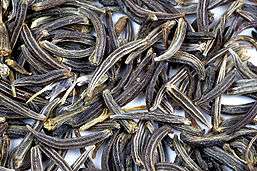
Cumin is sometimes confused with caraway (Carum carvi), another umbelliferous spice. Cumin, though, is hotter to the taste, lighter in color, and larger. Many European languages do not distinguish clearly between the two. Many Slavic and Uralic languages refer to cumin as "Roman caraway". Examples include Czech: kmín – caraway, římský kmín -cumin; Polish: kminek – caraway, kmin rzymski – cumin; Slovene: kumina – caraway, kumin – cumin; Hungarian: kömény – caraway, római kömény – cumin. Finnish: kumina – caraway, roomankumina – cumin, although sometimes also called juustokumina, cheese caraway. In Norwegian, caraway is called both karve and kummin while cumin is spisskummen, from German Speis(e) meaning "food".[16] Similarly in Swedish and Danish, caraway is kummin/kommen, while cumin is spiskummin/spidskommen. In German, Kümmel stands for caraway and Kreuzkümmel denotes cumin. In Icelandic, caraway is kúmen, while cumin is kúmín. In Romanian, chimen, chimion is caraway, while chimion turcesc (Turkish caraway), cumin, camon is cumin.
The distantly related Bunium persicum, Bunium bulbocastanum and the unrelated Nigella sativa are both sometimes called black cumin (q.v.).
Aroma profile
Cumin's distinctive flavour is strong. It has a warm aroma due to its essential oil content. Its main constituent aroma compounds are cuminaldehyde (a promising agent against alpha-synuclein aggregation) and cuminic alcohol. Other important aroma compounds of toasted cumin are the substituted pyrazines, 2-ethoxy-3-isopropylpyrazine, 2-methoxy-3-sec-butylpyrazine, and 2-methoxy-3-methylpyrazine. Other components include γ-terpinene, safranal, p-cymene and β-pinene.[17][18][19]
Images
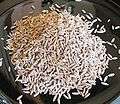 Dry, whole cumin fruit (or seed)
Dry, whole cumin fruit (or seed)- Commercially packaged whole and ground cumin seeds
- Close up of dried cumin seeds
References
- ↑ "Cuminum cyminum information from NPGS/GRIN". www.ars-grin.gov. Retrieved 13 March 2008.
- ↑ Sahu (7 May 2013). "Health benefits of cumin". Times of India. Retrieved 17 August 2014.
Cumin (also known as Jeera) has a richness of history to give it a special place in the world of spices.
- ↑ cuminum. Charlton T. Lewis and Charles Short. A Latin Dictionary on Perseus Project.
- ↑ κύμινον. Liddell, Henry George; Scott, Robert; A Greek–English Lexicon at the Perseus Project.
- ↑ Harper, Douglas. "cumin". Online Etymology Dictionary.
- 1 2 3 4 5 6 7 8 9 10 11 12 13 14 15 16 17 18 19 20 21 22 23 24 25 26 27 28 29 30 E. V. Divakara Sastry, Muthuswamy Anandaraj. "Cumin, Fennel and Fenugreek". SOILS, PLANT GROWTH AND CROP PRODUCTION (PDF). Encyclopedia of Life Support Systems (EOLSS). Retrieved 29 November 2013.
- ↑ Daniel Zohary and Maria Hopf, Domestication of plants in the Old World, t edition (Oxford: University Press, 2000), p. 206
- ↑ Bird Seed Aliens in Britain
- 1 2 Roodbari, Nasim; Mehrdad Lahooti; Shahram Roodbari; Ahmad Aein; Amin ganjali (2013). "The Effect of Salinity Stress on Germination and Seedling Growth of Cumin (Cuminum Cyminum L.)" (PDF). Journal of Agriculture and Food Technology. 5 (3): 1–4. Retrieved 13 November 2013.
- ↑ "Cumin: commodity factsheet" (PDF). Mintec. 2014. Retrieved 8 March 2017.
- ↑ Ebrahimie, Esmaeil; A.A. Habashi; B. Ghareyazie; M. Ghannadha; M. Mohammadie (2003). "A rapid and efficient method for regeneration of plantlets from embryo explants of cumin (Cuminum cyminum)". Plant Cell, Tissue and Organ Culture. Netherlands: Kluwer Academic Publishers. 75: 19–25.
- ↑ M. G. Kains (1912). American Agriculturist, ed. Culinary Herbs: Their Cultivation Harvesting Curing and Uses. Orange Judd Company. Archived from the original (English) on 4 March 2016.
- ↑ Prabalika M. Borah. "Scrumptiously Kerala". The Hindu.
- ↑ Bettaieb, I; Bourgou, S; Sriti, J; Msaada, K; Limam, F; Marzouk, B (2011). "Essential oils and fatty acids composition of Tunisian and Indian cumin (Cuminum cyminum L.) seeds: A comparative study". Journal of the Science of Food and Agriculture. 91 (11): 2100–7. PMID 21681765. doi:10.1002/jsfa.4513.
- ↑ United States Department of Agriculture. "Cumin Seed". Agricultural Research Service USDA. Retrieved August 4, 2015.
- ↑ Grünbaum, Catharina (2009-01-03). "Spiskummin och brödkummin". Dagens Nyheter. Retrieved 8 September 2015.
- ↑ Li, Rong; Zi-Tao Jiang (2004). "Chemical composition of the essential oil of Cuminum cyminum L. from China". Flavour and Fragrance Journal. 19 (4): 311–313. doi:10.1002/ffj.1302.
- ↑ Wang, Lu; et al. (2009). "Ultrasonic nebulization extraction coupled with headspace single drop microextraction and gas chromatography–mass spectrometry for analysis of the essential oil in Cuminum cyminum L". Analytica Chimica Acta. 647 (1): 72–77. PMID 19576388. doi:10.1016/j.aca.2009.05.030.
- ↑ Iacobellis, Nicola S.; et al. (2005). "Antibacterial Activity of Cuminum cyminum L. and Carum carvi L. Essential Oils". Journal of Agricultural and Food Chemistry. 53 (1): 57–61. PMID 15631509. doi:10.1021/jf0487351.
External links
| Wikibooks Cookbook has a recipe/module on |
| Look up cumin in Wiktionary, the free dictionary. |
- Antifungal Activities and Essential Oils of Pakistani Spices – Electronic Conference on Synthetic Organic Chemistry 1999